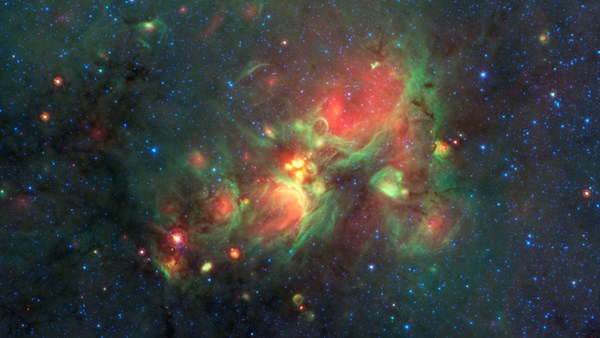CHICAGO, Jan. 28, 2015 (GLOBE NEWSWIRE) -- A paper published Monday by the Astrophysical Journal, The Milky Way Project: What are Yellowballs?, presents a new method of detecting the early stages of massive star formation. The discovery stems from more than 900 mysterious bright yellow objects found by citizen scientists working on the Milky Way Project, an online research project, built by Zooniverse, that asks the public to classify tens of thousands of images to better understand how stars form.
In the Milky Way Project, volunteers scan through Spitzer Space Telescope images of the thick plane of our galaxy, where newborn stars are igniting in swaths of dust. The infrared wavelengths are assigned visible colors that can be seen by the human eye. Green bubbles with red centers populate a landscape of swirling gas and dust. These bubbles are the result of massive stars blowing out cavities in their surroundings.
Four years ago, citizen scientists started reporting more and more fuzzy yellow objects when searching for these bubbles. The objects were unfamiliar and sparked discussion among the professional astronomers on the Milky Way Project, eventually leading to a study of the objects, which are now known as "yellowballs."
"Yellowballs are missing links between the cold, dusty clouds that give birth to stars and the extremely hot bubbles that form as massive young stars sculpt their environments," said Grace Wolf-Chase, PhD., Adler Planetarium astronomer and co-author of the study. "Their discovery may help us understand the environment in which our own Solar System formed."
Despite the name, the yellow objects found in Spitzer's infrared images are not actually yellow. When the images are made, various colors are assigned to represent different wavelengths of infrared light. The yellow color on the images displays where emissions from molecules, highlighted by green, and dust, highlighted by the color red, completely overlap.
A thorough analysis by the authors led to the conclusion that the yellowballs precede the green bubble features, representing a phase of star formation that takes place before the bubbles form.
"With the prompting by the volunteers, we analyzed the yellowballs and figured out that they are a new way to detect the early stages of massive star formation," said Charles Kerton, PhD., Iowa State University associate professor of physics and lead author of the study. "The simple question of 'Hmm, what's that?' led us to this discovery."
The Milky Way Project is part of Zooniverse, a nonprofit collaboration led by the Adler Planetarium and University of Oxford. Zooniverse is the world's leading – and largest – collection of citizen science projects, which has engaged more than 1.2 million online volunteers as active scientists on more than 30 science projects. More than 70 scientific papers have resulted from Zooniverse projects, four of which are connected to the Milky Way Project.
To date, citizen scientists have made nearly 1.5 million classifications for the Milky Way Project. The data are helping astronomers study and map star formation within the galaxy. The project took on a new focus when citizen scientists noticed yellow objects along the rims of some bubble formations. The astronomers began studying those yellowballs by comparing them against existing catalogs of space objects. They also studied the luminosity and physical sizes of 138 of the yellowballs.
The authors have found that these yellowballs were located in regions of the galaxy containing dense gas. They also found their luminosity was consistent with what is expected for a collection of newly formed massive stars. The paper concludes that there is an early "yellowball stage" in the formation of stars 10 to 40 times as massive as our Sun. The yellowballs are considered very young versions of the bubble formations.
So far, the volunteers have identified more than 900 yellowballs. The next step for the researchers is to look at the distribution of the features. Many appear to be lining the rims of the bubbles, a clue that perhaps the massive stars are triggering the birth of new stars as they blow the bubbles, a phenomenon known as triggered star formation. If the effect is real, the researchers should find that the yellowballs statistically appear more often with bubble walls.
The astronomers also wrote that further studies of yellowballs will improve our understanding of how regions of massive star formation grow from early compact stages to more evolved bubble-like structures.
Additional co-authors of The Milky Way Project: What are Yellowballs? include Kim Arvidsson, PhD., former postdoctoral scholar at the Adler Planetarium and presently an assistant professor of physics and astronomy at Schreiner University in Kerrville, Texas and Chris Lintott, PhD., Zooniverse co-founder and Robert Simpson, PhD., operations lead for Zooniverse, both are based at the University of Oxford.
About the Adler Planetarium
The Adler Planetarium—America's First Planetarium—was founded in 1930 by Chicago business leader Max Adler. A recognized leader in public learning, the Adler Planetarium inspires young people to pursue careers in science, technology, engineering and math. Scientists, historians and educators at the museum inspire the next generation of explorers.
A photo accompanying this release is available at: http://www.globenewswire.com/newsroom/prs/?pkgid=30343
CITIZEN SCIENTISTS LEAD ASTRONOMERS TO MASSIVE STAR COCOONS
Mystery Objects Are Missing Link in Star Formation in Our Galaxy
| Source: Adler Planetarium
